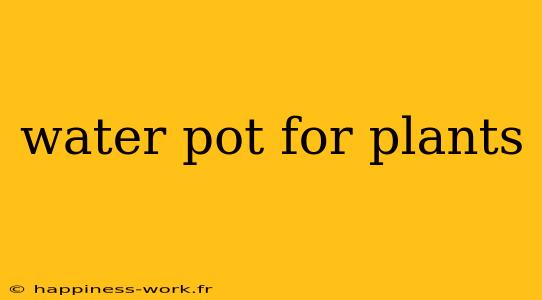Watering your plants correctly is one of the most crucial aspects of plant care. A well-designed water pot can make this task much easier and more efficient. In this article, we will explore various types of water pots for plants, how to choose the right one, and some innovative ways to use them. We'll also provide you with insights and tips that aren't readily available elsewhere to help you become a better plant parent.
What is a Water Pot for Plants?
A water pot, or watering can, is a container specifically designed to hold water for the purpose of watering plants. It typically features a spout for directed pouring and a handle for ease of use. These tools come in various materials, sizes, and styles, catering to different types of gardening and personal preferences.
Types of Water Pots
Here are a few popular types of water pots for plants, along with their specific uses:
-
Standard Watering Can
This is the most common type, typically made from plastic or metal. It is versatile and suitable for most houseplants and outdoor gardens. The size often ranges from 1 to 5 gallons. -
Indoor Watering Can
These are generally smaller, lighter, and designed with a long spout to reach those tricky spots in your houseplants. Their aesthetics often match home decor. -
Self-Watering Pots
These pots come with a built-in reservoir that allows plants to absorb water as needed, reducing the frequency of watering. They are ideal for busy gardeners or those who travel frequently. -
Drip Irrigation Systems
While not a traditional pot, these systems allow for efficient watering directly to the plant's roots. This is especially useful for garden beds or larger plants. -
Watering Globes
These glass or plastic bulbs release water slowly over time, making them great for indoor plants and reducing the risk of over-watering.
How to Choose the Right Water Pot?
When selecting a water pot for your plants, consider the following factors:
-
Size of Your Plants: For larger plants or garden beds, a larger watering can or system may be necessary, while smaller plants can be watered using a small indoor watering can.
-
Material: Metal watering cans are durable but may rust, while plastic can be lightweight and rust-free. Choose based on your specific needs and aesthetic preference.
-
Spout Design: A longer spout can provide more precision in watering, which is especially helpful for indoor plants with foliage that’s easy to hit while watering.
-
Ergonomics: Ensure the handle is comfortable to grip and that the overall design makes watering easy and efficient.
Practical Example: Choosing a Water Pot for a Cactus
When watering a cactus, it’s essential to avoid over-watering. A self-watering pot can be an ideal choice, allowing for gradual moisture release. Alternatively, a standard watering can with a long spout will let you pour directly onto the soil without splashing water onto the leaves.
Additional Tips for Using Water Pots Effectively
-
Watering Frequency: Adjust your watering based on the season. In warmer months, plants usually require more water, while in winter, they may require much less.
-
Fertilizing While Watering: You can add liquid fertilizers to your water pot to nourish your plants while watering, making the process more efficient.
-
Cleaning Your Watering Can: Make sure to clean your watering pot regularly to prevent algae growth and the spread of diseases among your plants.
-
Use Rainwater: If possible, collect rainwater in your watering pot. It is often more beneficial for plants than tap water because it is free from chemicals like chlorine and fluoride.
Conclusion
Choosing the right water pot for your plants is essential for their health and growth. Understanding the different types available and knowing how to use them effectively can save you time and help your plants flourish. By integrating additional tips and insights into your plant care routine, you can create an optimal environment for your greenery to thrive.
Remember, the more informed you are about your plants' watering needs, the better equipped you will be to provide them with the care they require. Happy gardening!
References:
- WikiHow Contributors. “How to Water Plants.” WikiHow, 2023.
- WikiHow Contributors. “How to Choose a Watering Can.” WikiHow, 2023.
By utilizing quality information and reliable sources, you can ensure your plant care methods are both effective and informed, making gardening a rewarding hobby.
